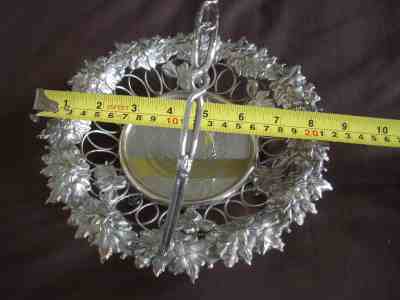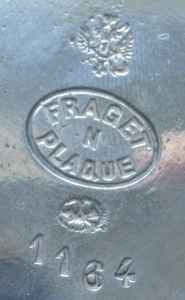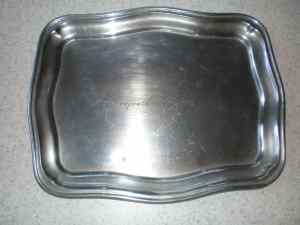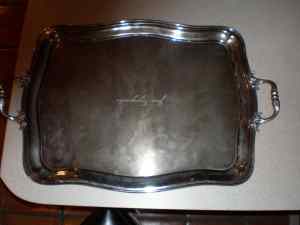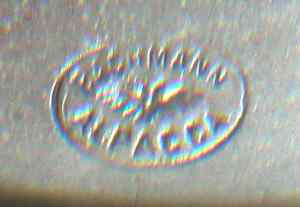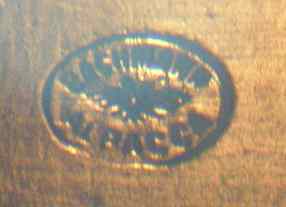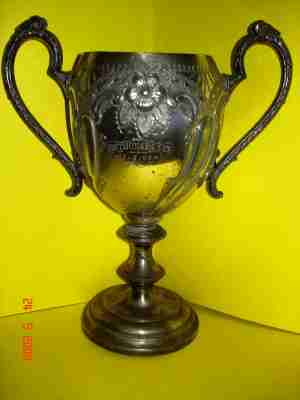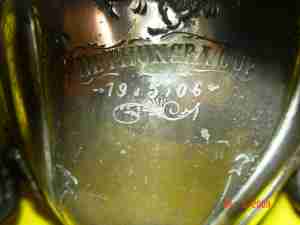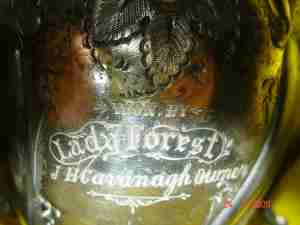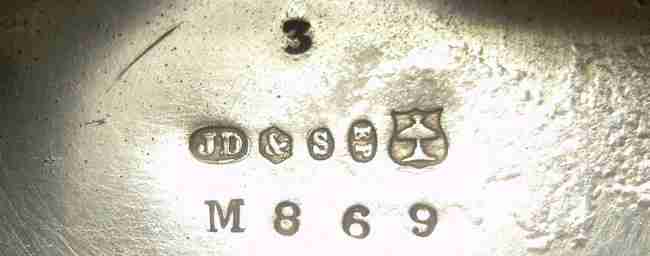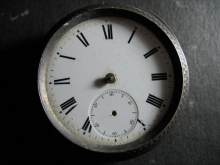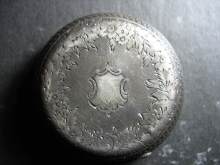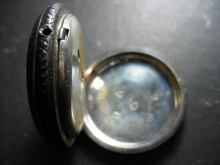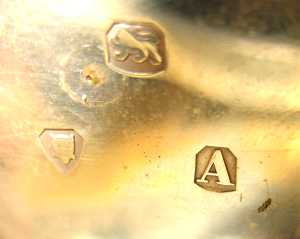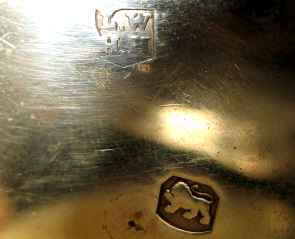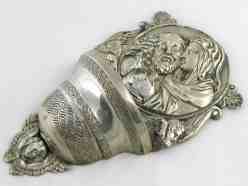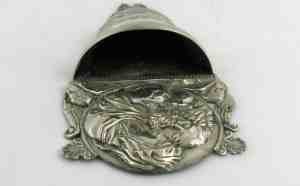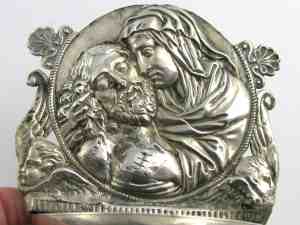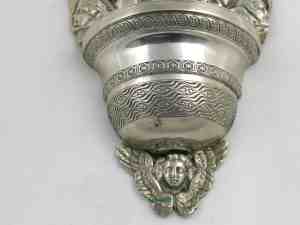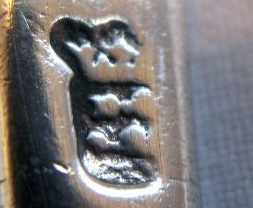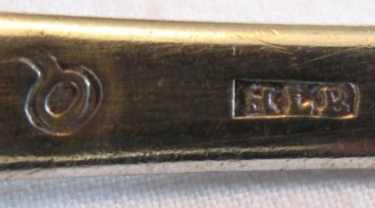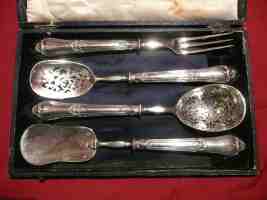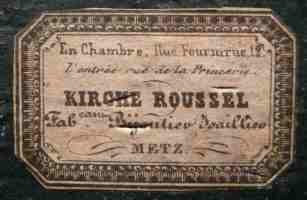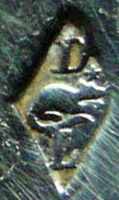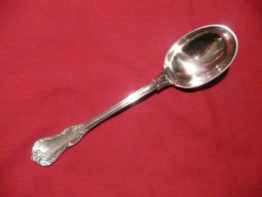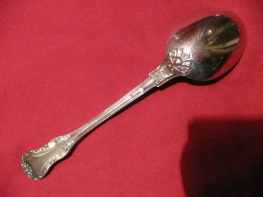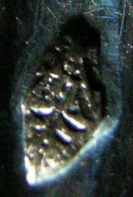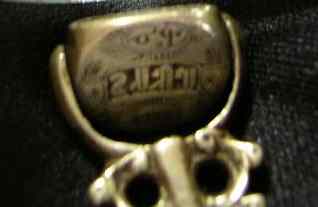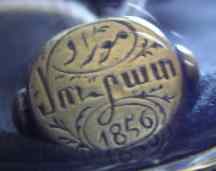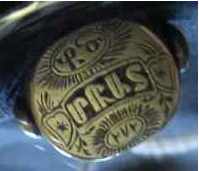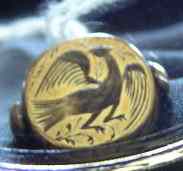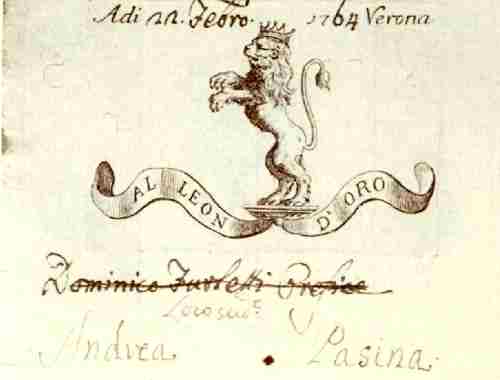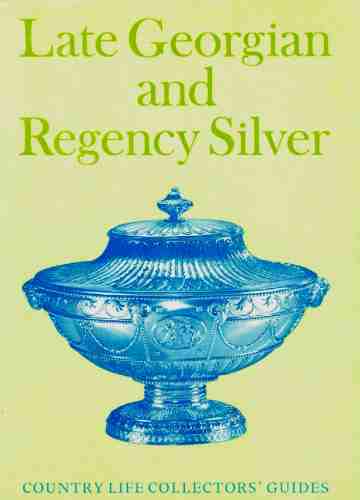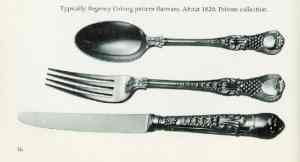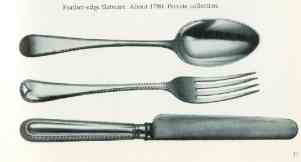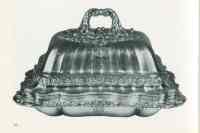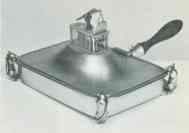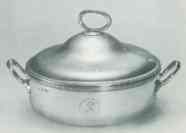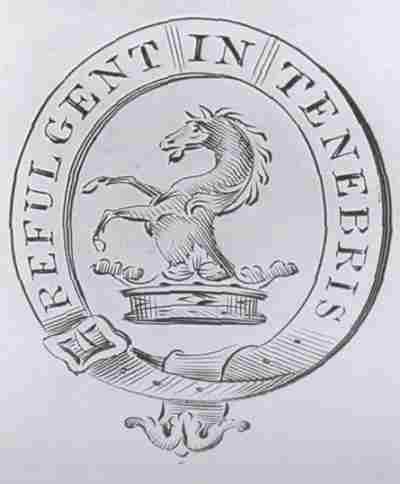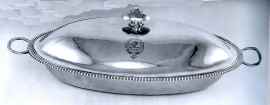 newsletter # 62 JULY 2009
newsletter # 62 JULY 2009www.ASCASonline.org SITE MAP
email: silverassociation@yahoo.it
YOUR GUIDE TO JULY NEWSLETTER:
articles new members
members' window
|
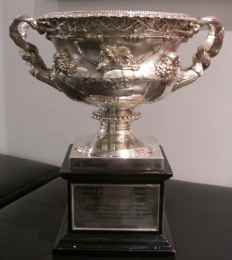
Christine Erratt presents:
click here
|
New members
Welcome to new ASCAS members:
Robert P. Barry - USA
Lazar Freidgeim - USA
Kathleen Geyer - USA
Christopher Sly - Argentina
Joanna Thomson-Zane - USA
Alan Weber - England UK
|
top page -
page map |
Members' Window # 62
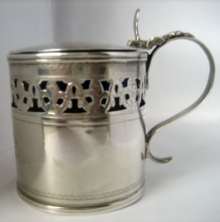
Robert Massart presents
|
Mail to ASCAS: e-mail silverassociation@yahoo.it
Francois C. writes:
...I get 11 knifes the handle are in full silver and the blade
are forged in steel. Nine of them probably arrived from Italy,
Venice end of the 18th century as beside the winged lion marks
they have another mark, three crescent moons between an F and
G. The other three, same model, are younger I think!
If hope that somebody can say to me the age and the name of the
silversmith of the 2 kinds of knifes.
Thank you
Francois
these are the information I found about your marks:
- lion: is one of the shapes in use in Venice in the 17th and
18th centuries until 1810
- horse's head: is the mark used in Venice from December 25,
1810 until 1872 c. to identify silver items made before 1810
- FC with three crescent between: is mark #163 in Piero Pazzi
book. Used at the end of the 18th c. beginning 19th c. (date
1805), possibly belonging to an unidentified assayer
-round mark DG with a flower between: it's a maker's mark not
present in Piero Pazzi book nor in Donaver-Dabbene.
Giorgio Busetto
Malcolm Rice writes:
I read and enjoyed the very interesting article on fraudulent
mote spoons by David Mckinley (see
May Newsletter). I would, however, have reservations where
he says he has experimented with tea and does not think mote
spoons were used to scoop motes from tea cups. I wonder what
sort of tea was used for the experiment.
During my working life I travelled extensively through India and
the Far East and quite often bought tea from local tea merchants.
That tea contained leaves which had been very roughly cut so
that it was possible to get a tea leaf a third or a quarter the
size of a whole leaf, more than large enough be apprehended by a
mote spoon should the leaf escape the teapot and I suspect 18th
century tea to be of the same roughly cut sizes rather than the
dusty item we are presented with today.
Many thanks
Kind regards
Malcolm Rice
Moira Merryweather writes:
...I came across your site while researching a dish that
belonged to my grandmother. She was a governess (1910s) to the
children of a family whose father was Count Sollohub attached to
the Imperial yacht 'Standart'.
The dish is 22cm across with ivy leaves and acorns (?)
decoration. It stands on 3 feet and has a handle. On the back of
the central metal part is stamped Fraget N Plaque in an oval.
Above that is a double-headed eagle and below another image
which is indecipherable. There are also the numbers 1164.
I don't know how my grandmother obtained the dish - maybe it was
a wedding present - but I will treasure it. Only a few items
came back from Russia when she had to leave Odessa suddenly
because of the Bolshevik advances and it was considered too
dangerous for the Britons to stay. Sadly my grandfather, who was
working for the British Consulate in Vladivostok never returned.
He contracted smallpox and died in 1924. I never met my
grandmother as she died long before I was born but through
research I have found out much about her life in Russia.
I would love to find out more about this dish and wonder if you
can point me in the right direction.
Any help would be very much appreciated.
Moira Merryweather
These are the information supplied by Prof. David Nikogosian:
This little basket was made in Poland (in that time part of
Russian Empire) in 1896-1915 by Fraget.
The inscription FRAGET N PLAQUE means Fraget silver plate on
Alpacca (nickel-copper-zinc alloy).
In the small oval there is the coat of arms of the coppersmiths’
corporation (two crossed hammers with a pair of compasses). The
coat of arms of the Russian Empire (double-headed eagle) on the
mark means a gold medal at the All-Russia Exhibition of
Manufactured Goods or the sign of the official purveyor to the
Court of His Majesty Russian Tsar.
Further details on Fraget factory are in my member's widow:
http://www.ascasonline.org/windowFEBBRA57.html
Prof. David Nikogosian
Joanne Nikides writes:
...We have two trays that belonged to our great uncle. One is 7
3/4" by 10", and has no handles. The other is 27 1/4" by 18
1/4", and has handles. Both trays have the same "insignia/stamp"
on them, at the middle of the left edge. The insignia/stamp
measures 1/4" by 3/16" and says "BACHMANN ALPACCA" with a bird
in the middle, separating the two words. The "BACHMANN" is on
top and the "ALPACCA" is on the bottom.
We have some information about Berndorf metalwork factory which
developed the alpacca alloy, but we don't know how Bachmann fits
in, and when and where this tray might have been made.
Could you help us with information or references?
Thanks,
Joanne Nikides
Dennis Rogers writes:
...Greetings Giorgio,
I contacted you earlier this year to ask about my late
Father-in-law’s watch plus my late Sister’s napkin ring. You
responded with a wealth of information for which I am genuinely
grateful.
Another item has been found in my late father-in-law’s
possessions for which I seek your knowledge.
This is not a small item. It is a trophy cup won by a horse
(trotter I think).
I have searched your database and think I have identified some
of the markings under the base but I am uncertain. There are
initials:
JD & S but these are all separate, not within a shield.
EP, which could be Edward Power or Edward Pairpoint
he third image has be baffled. It appears to be a tree inside a
shield. I cannot find any reference to this.
There are two other numbers but these I suspect are item or
catalogue numbers. There is a 3 above the images and M869
beneath the images.
I have attached some photographs of the cup and the under-base
images for your examination which should assist.
The cup is engraved 1906 and Bethungra is a town in NSW,
Australia. This may give you a clue as to its maker.
Bethungra is about 20kms SW of the larger NSW town of
Cootamundra. From Sydney the total distance is 415kms and takes
just over 4 hours to drive.
The trotter was named Lady Forest and was owned by J.H.
Cavanaugh.
Cavanaugh was my late mother-in-law’s maiden name and the cup
came from her side of the family. I am not sure if the cup was
her father or perhaps one of her uncle’s but I do know they were
involved in the Trotting industry in those days.
The cup (to the lip) is 23cm tall (26 cm to the top of the
curved handles).
Diameter is 12cm (22cm with the handles). Weight is 835 gm.
The handles have a ram’s head at their apex.
The silver appears to be plated over some other metal (pewter?)
and it has eroded in numerous places. The scrollwork and design
work is intricate, unlike the more plainer designs of today.
Best Wishes,
Dennis Rogers
The maker of your cup is James Deakin & Sons, Sheffield (UK).
EP signifies Electro Plated (silver) see information about the
maker in my website at
http://www.silvercollection.it/electroplatesilverD.html.
By the way, the "tree inside a shield" is a table bell (of the
type used in the desk of hotel's reception)
Giorgio Busetto
Martin Healy writes:
...I am trying to find out more information about the watch in
the attached pictures. I am having trouble trying to decipher
who manufactured this, as I live in Australia, and most people
here don't know where to start. I have attached some pictures,
and if you could assist me with any information, or point out
where I should go to get this, this would be appreciated.
Kind regards,
Martin Healy
The maker is Louis Weill & Henry Harburg, case makers,
mark registered 1876, defaced 1879. The case is marked London
1876. Some information about the maker:
Louis Weill commenced his business in 1863 c. until 1876 c.
In 1876 entered in business with Henry Harburg. In 1879 Weill &
Harburg had as partners L. Weill, H.Harburg and Charles Feis as
wholesale and export watch manufacturers in London (Holborn
Circus) and Chaux de Fonds, Switzerland.
Chronology of the firm: Weill & Harburg (c.1876-1890), Louis
Weill (& Co) (1890-1896), Weill & Co (1896-1919), Arthur Mayer &
L. Weill (c. 1919-1928), Arthur Mayer (1928).
Giorgio Busetto
John J. Yale writes:
...I’d be grateful if you could cast your eye over the attached
pictures. I assume that this is Milan 800 silver from about
1820?
John J. Yale
You are right: the marks of your holywater font belong to
Lombardo Veneto. The maker is Bozzolo Saverio, active c.
1827/1852.
Further information about Lombardo Veneto marks (Milano) in my
website at
http://www.silvercollection.it/LOMBARDOVENETOHALLMARKS.html
and further holywater fonts at
http://www.silvercollection.it/dictionaryholywaterfont.html
Giorgio Busetto
H. Dinerstein writes:
...I attach photos of a silver object marked 'AR' twice which is
6 1/2" long and 1/2" wide at its widest point and weighing 13
grams. Each end is decorated with pierced leaves and flowers. I
have no idea what it was used for. Perhaps you can help.
Regards
H. Dinerstein
Any suggestion (a bookmark?) will be welcome
Giorgio Busetto
Christophe Ginter writes:
...I would like to identify the marks of two items:
- first item = "crowned double symbols" and "a Q (warranty ?)
and HLB (maker's mark)"
- second item = "an identical crowned figure" "P" and "maker's
mark = BARTH"
I would think for Dutch hallmarks.
Thank you in advance for your help.
Christophe Ginter
Another challenge for ASCAS members well acquainted with
Dutch/Belgian marks?
Giorgio Busetto
Alessandro Colemann writes:
I'm trying to identify the makers of a silverware set and a
spoon with French hallmarks (Minerva).
Any suggestion will be greatly appreciated.
Alessandro Colemann
Dominique Bochet writes:
.... I bought four silver spoons but I need your help to
identify their marks.
Bien cordialement
Dominique Bochet
Replies to questions
Wayne Robbins receives these replies about his "Russian"
seal
(see June 2009 Newsletter)
David Nikogosyan writes:
...I know the key to the puzzle presented by Wayne Robbins,
this seal carries some lettering in Armenian. This seal is
probably made not in Russia, but in Turkey, Syria or Iran, where
significant Armenian colonies existed at that time.
My relative told me that on both sites of the seal in the centre
the same name is inscribed:
Murat (or Mourad in Arabic), once in capital letters, once in
small letters.
Hope it will help. David.
David Nikogosyan
Bronia Wulich writes:
....I did some research about the seal of Wayne Robbins. My
founds are:
1. The language of the seal is definitely not Russian. Not
modern and not old Russian
(Staroslavianski;
2. There is a number 272, also in Arabic - see the first picture;
3. There is a word written in Arabic, probably meaning "original"
- see the second picture;
4. The rest of the letters are probably in Armenian.
Best regards,
Bronia
"A PAGE per MONTH"
In this column we present a page
obtained from makers' brochures, books, auction catalogs,
advertising or whatever other printed paper, related to silver,
that may be of interest for ASCAS members.
The images will be published at a "low resolution" level and for
private and personal use only
"A WORD per MONTH"
In this column we presents an abstract
from a page of the "What is? Silver Dictionary"
courtesy of
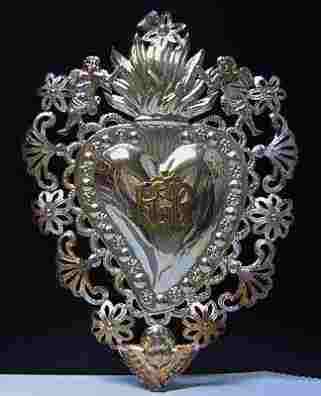
|
EX VOTOAn ex-voto is a votive offering to a saint or
divinity. It is given in fulfilment of a vow (hence the
Latin term, short for "ex voto suscepto", or "from the
vow made") or in gratitude or devotion. Ex-votos are
placed in a church or chapel where the worshipper seeks
grace or wishes to give thanks. The destinations of
pilgrimages often include shrines decorated with
ex-votos......
|
"A BOOK ON MY SHELF"
In this column we present books, new
or ancient, dealing with silver in all its aspects (history,
marks, oddities...). This isn't a "book review" but only a fair
presentation of some useful "tools" that anyone may have in the
shelf of his bookcase.
ASCAS members are invited to contribute to this column
(click to enlarge images)
The "book on my shelf" of this month presents:
LATE GEORGIAN AND REGENCY SILVER
by Judith Bannister
Country Life Collector's Guides
The Hamlyn Publishing Group Limited 1971
by Judith Bannister
Country Life Collector's Guides
The Hamlyn Publishing Group Limited 1971
"A CREST per MONTH"
In this column we present images and description of Crests and Mottoes of British, Irish and Scottish Families as engraved in silver items.
Closing our JULY 2009 edition of ASCAS Newsletter I hope you have appreciated its content.
Your comments, suggestions and advice will be of great help.
My thanks to Dominique Bochet, Alessandro Colemann, Jayne Dye, H. Dinerstein, Christine Erratt, Christophe Ginter, Martin Healy, Peter Lockett, Robert Massart, Moira Merryweather, Joanne Nikides, David N. Nikogosyan, Malcolm Rice, Dennis Rogers, Bronia Wulich, John J. Yale, for their invaluable contributions.
Giorgio Busetto
Secretary
ASCAS is a community of people having a common
interest in antique silver.
|






